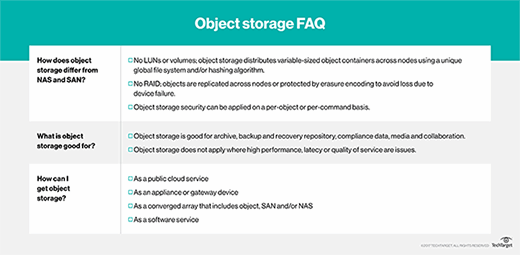
Rawpixel - Fotolia
Evaluate cloud-based object storage for backup
Explore the benefits of backing up to object storage in the cloud and why it's important to consider providers' pricing, connectivity options and features.
Although disk and tape have historically been the go-to media types for backups, object storage is quickly becoming the preferred option to store backup data.
Object storage -- especially, cloud-based object storage -- holds a number of advantages over other backup types, including the potential to reduce an organization's costs. Even so, there are several elements to consider before adopting object storage for backup.
Why is cloud-based object storage good for backup?
There are two main reasons why cloud-based object storage is a good option for backups. First, it provides unlimited scalability; it doesn't run out of space like disk- or tape-based backup products can.
The second advantage is that cloud providers offer pay-as-you-go pricing. This eliminates the need to purchase the pricey hardware required for on-premises backups. Additionally, object storage tends to have a lower cost per gigabyte than other types of storage.
3 considerations for cloud-based object storage
Before adopting cloud-based object storage for backup, carefully consider costs, connectivity options and cloud providers' feature sets.
1. Cost
All of the major cloud service providers offer object storage, but their prices vary considerably. Some providers' rates vary by region, as well. In some cases, users can switch to a different region to get a better price.
2. Connectivity
Consider how the backup application will attach to the cloud-based object storage. There are two main options for connectivity.
The first option is to use a cloud storage gateway. The gateway is a physical or a virtual appliance that acts as a backup target, often by emulating a virtual tape library. Backups are written to the cloud storage gateway and then replicated to cloud-based object storage. The advantage of this approach is that some gateways are equipped with physical storage, which means a copy of the backup will be retained locally. The existence of a redundant, on-site backup copy can expedite restore operations because on-premises data does not have to be restored from the cloud.
The second option to attach to object storage for backup in the cloud is to use the backup software's native capabilities. All the major cloud providers offer APIs that enable backup vendors to directly support the cloud provider's storage. The main advantage of this approach is that, because support for cloud-based object storage is built directly into the backup application, it's a simple process to connect to and use object storage.

Unfortunately, a backup application is unlikely to offer native support for every cloud storage provider, so determine which clouds the backup application will work with. Some cloud providers have created object storage that will work with another cloud provider's APIs. For example, there are some smaller cloud storage providers that are AWS S3-compatible, meaning that if a backup application natively supports AWS S3, then it should work with those clouds as well.
3. Feature sets
Organizations should also consider available features. Each cloud provider has its own set of features relative to object storage for backup. For example, a provider might offer the ability to automatically replicate backup copies to additional regions. Similarly, some cloud providers give you the ability to archive older data to a less expensive storage tier.








